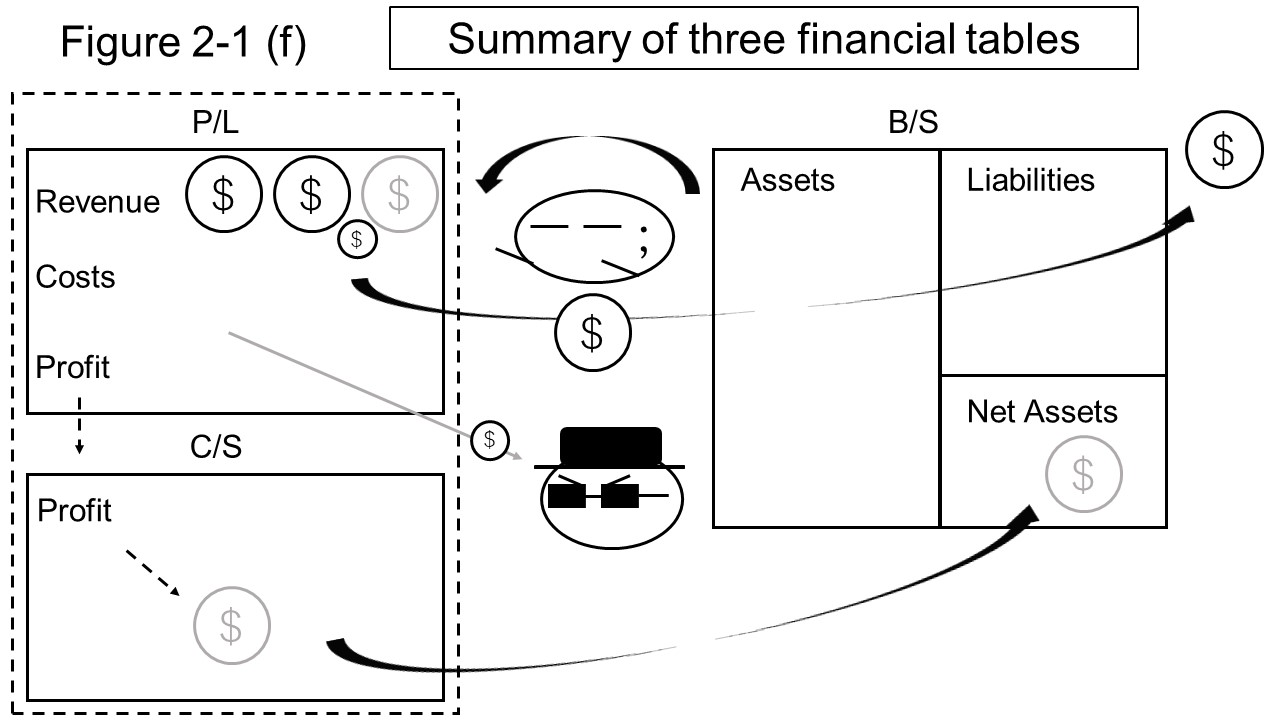Buying stock means becoming a shareholder or owner (hereinafter referred to as shareholder) of the company that issued the stock.
Although there are various perspectives on what kind of value companies have, there is a value related to earnings or assets as a value commonly found in any company.
A company's earnings and assets are summarized in its financial statements.
Main financial statements are Balance Sheet (B/S), Profit and Loss Statement (P/L), Statement of Comprehensive Income (Comprehensive Income Statement : CI/S), Statements of Shareholders' Equity (S/S), and Cash Flow Statement (C/F).
ref 1
In Japan, these financial statements are listed in securities reports and earnings report that are published periodically.
When investing in stocks, it is important to understand the company's earnings and asset value.
Therefore, this page will outline the balance sheet, profit and loss statement, comprehensive income statement, and cash flow statement among the financial statements for the purpose of understanding them.
Please note that this website mainly deals with financial statements prepared under Japanese generally accepted accounting principles (Japanese GAAP).
ref 2
The reason why this website is based on Japanese GAAP is that it is easy to explain corporate activities related to investment by accounting rules.
In Japan, listed companies are demanded to prepared their financial statements and disclose them through securities reports, etc. under laws such as the Financial Instruments and Exchange Act.
ref 3
And, One of the accounting standards recognized in Japan for the preparation of financial statements is Japanese GAAP.
Japanese GAAP have been influenced by Japanese laws and regulations, and have detailed rules established through the Accounting Standards Board of Japan.
For this reason, among several accounting standards, Japanese GAAP has the advantage of being less likely to cause misinterpretation for an unspecified number of readers.
Also, accurately describing the first accounting standard would makes it easier to explain other accounting standards.
On the other hand, Japanese accounting standards differ from overseas accounting standards in some respects, and it is difficult to compare Japanese companies and foreign companies based only on Japanese accounting standards.
Therefore, this website will explain the business activities and management of companies, using the accounts listed in financial statements based on Japanese GAAP, and also touch on how to read financial statements based on IFRS as appropriate.
- Securities report
- It is described "有価証券報告書", and called "yuukasyouken houkokusyo", in Japan.
- Earnings report
- It is described "決算短信", and called "kessan tanshin", in Japan.
The balance sheet is a financial statement that describes the financial status of the company at the time of closing.
- Balance sheet
- Under Japanese GAAP, it is written as "貸借対照表", and called "taisyaku taisyouhyou". But its IFRS version is written as "財政状態計算書", and called "zaisei jyoutai keisan syo".
Balance sheet has a structure that is divided into left and right.
The left side is called debit, the right side is called credit on balance sheet.
On balance sheet, the former is the assets of the company, but the latter is the assets of others.
Assets is described on the left, Liabilities and Net Assets is described on the right, on the balance sheet.
it is called the balance sheet (B / S) because the total amount on the left and right is always balanced.
Assets include mainly the property and regal right of a company that is expected to generate profits.
On the other hand, Liabilities include mainly debt to others.
Net assets is the difference between assets and liabilities, which represent the capital from shareholders and the accumulated profit of the company.
Figure 2-1 (a) shows the rough structure of the balance sheet.

Assets are classified into current assets and fixed assets, and liabilities are classified into current liabilities and fixed liabilities.
"Current" and "fixed" are like the speed at which money moves.
"Current" means that it is planed for money to move within one year from the closing date, and "fixed" means that it is not planled for money to move within one year from the closing date.
More precisely, assets / liabilities generated in the operating cycle on business and assets / liabilities scheduled to move within one year are given the word “current”.
Net assets are categorized into shareholders' equity and accumulated other comprehensive income, and non-controlling interests.
More precisely, there are also stock acquisition rights, but it is ignored here.
Shareholders' equity represents the capital paid by the investor and the accumulation of realized profits.
Accumulated other comprehensive income is the accumulation of unrealized valuation gains and losses.
Non-controlling interest is a portion that belongs to a shareholder other than the parent company which submits the financial statement, of subsidiary stock.
Assets and liabilities on the balance sheet are related to revenues and costs and they are not directly linked to cash flow.
However, the function of the balance sheet is explained here on the assumption that revenue and cash inflow, cost and cash outflow are the same, respectively.
Please chack the exact details in the income statement section below.
The left side of the balance sheet is an asset prepared by the company, which represents what is necessary to do business.
On the other hand, The right side comprise of liabilities that are expected to make cash outflows in the future, and net assets that are the defference between assets and liabilities.
As is clear from the structure, assets and liabilities are not symmetric in the balance sheet.
Cash inflows from assets are uncertain, but cash outflows to liabilities are almost certain.
Because cash inflows are mainly a business issue, but cash outflows often involve legal responsibility.
And the accumulation of uncertainties in net profit so far appears in net assets.
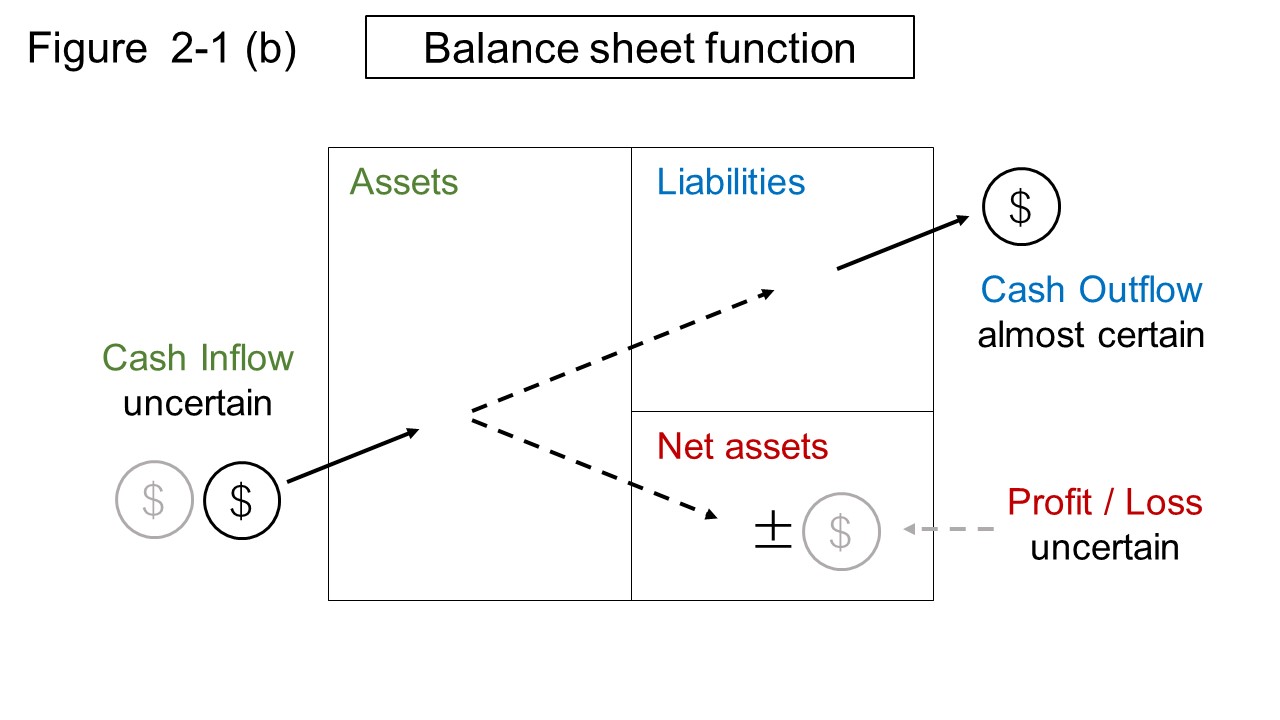
Liabilitis are liabilitis for the company, but Assets for a creditor.
Net assets are also assets of others, of which Shareholders' equity are assets that clearly belong to the shareholders.
Accumulated other comprehensive income is unrealized valuation profits and losses, and although there are some vagueness depending on the breakdown, it is generally regarded as a shareholder's asset.
As long as assets, liabilities and net assets are someone's assets, important thing is not only the amount.
It is also important how much money they have generated.
The balance sheet shows the financial status of a company at a certain point in time, and can be said to be stock information.
By comparing the balance sheet with the past balance sheet or reading it together with the income statement and cash flow statement, you can understand the business situation of the company including the flow information.
There are two types of profit statements.
The first profit and loss Statement (hereafter, income statement) is a statement that calculates net income from the revenues and expenses recognized in the business.
Net income is added to the Shareholders' equity on the balance sheet.
The second statement of comprehensive income is a statement that calculates other comprehensive income which is the profit that cause fluctuations in net assets due to factors other than net profit.
Other comprehensive income is added to the accumulated other comprehensive income on the balance sheet.
- Profit and Loss Statement (Income Statement)
- It is written as "損益計算書", and called "son eki keisan syo", in Japan.
- Comprehensive income statement
- It is written as "包括利益計算書", and called "houkatsu rieki keisan syo", in Japan.
Income statement is a financial statement that describes the income and expense for a certain period, which lead to realized profit and loss of the company.
In the income statement, costs are deducted in order from net sales, and operating profit, which is the profit of the main business, is first obtained.
The main business here means the business specified as the purpose of the business in the articles of incorporation.
Finally, taxes are adjusted with respect to the net income before taxes to obtain the net income.
Figure 2-1 (c) shows the outline of the income statement.
There are some profits other than those shown in the figure, in the actual income statement.
Only the outline is described on this page, and the details are described on another page.
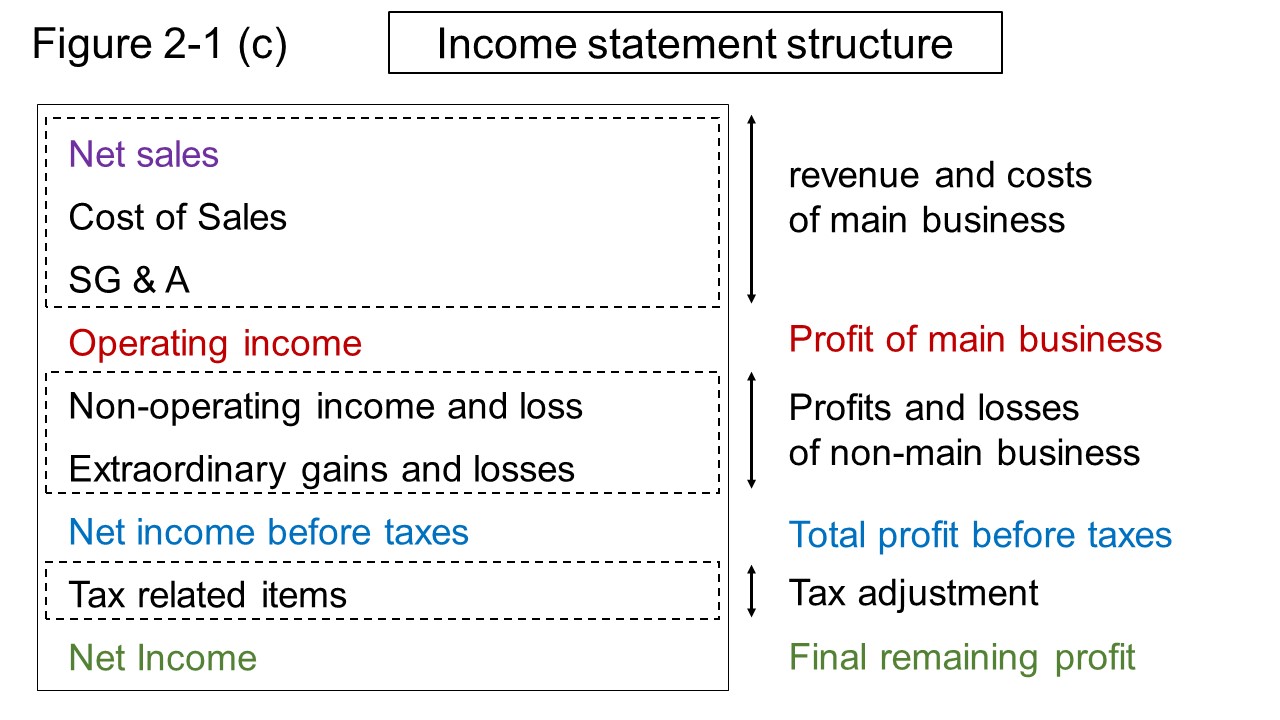
Net sales on the top represents the revenue earned by the company in its main business.
Gross profit can be obtained by subtracting the cost of sales from net sales, which means the margin for the cost of the marchandise, product or service (hereinafter, product, etc.) itself.
Operating income is the gross profit minus selling, general and administrative expenses (hereinafter referred to as SG & A expenses)
Operating income is the profit obtained from the main business.
Ordinary income can be obtained by adding non-operating income and expenses which is ordinary income and expenses from other than the main business, to operating income.
Non-operating income and expenses is the accompanying profit / expenses that occurs on a ordinary processes of operation in the business that are not the purpose of the business.
Net income before taxes is the sum of ordinary income with extraordinary income and loss that are extraordinary gains and losses other than the main business.
Taxes are deducted from net income before taxes, and the profit that remains in the company is the net income.
Net income is the profit attributable to shareholders that remains after deducting all costs from all income of the company.
The income statement is a financial statement that shows profit and loss, but profit and loss do not match cash flow.
This is because it is common for companies to trade by credit or to divide the purchase cost of fixed assets.
Therefore, even if a company makes a profit, it does not always mean that it will receive cash equivalent to the profit.
In order to obtain cash information, it is necessary to check the cash flow statement in addition to the income statement.
Comprehensive income statement is a financial statement that reports the comprehensive income of a company over a period of time.
Comprehensive income is the difference between net assets on the balance sheet for the previous period and the current period.
The difference is the sum of net income which is realized profit and loss in the income statement and other comprehensive income which is valuation profit and loss not counted in the income statement.
Since net income is reported in the income statement, only other comprehensive income is additionally reported in the comprehensive Income statement.
Comprehensive income = Net income + Other comprehensive income
Comprehensive income statement has the structure shown in the figure 2-1 (d) below.
The individual financial statements and the consolidated financial statements, including subsidiaries, differ only in the part of the profit attributable to non-controlling interests.
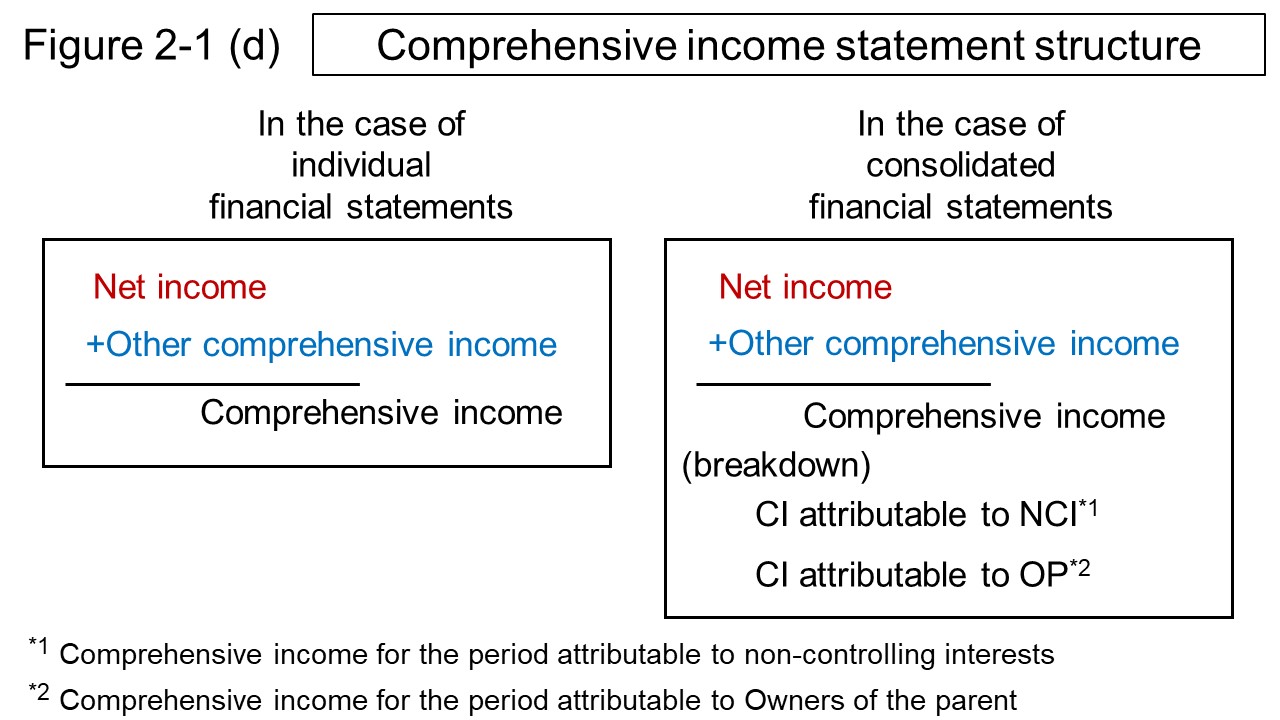
The relationship between the balance sheet and the comprehensive income statement is shown in Figure 2-1 (e).
Comprehensive income which is sum of the net income and other comprehensive income is consistent with changes in net assets over the same period.
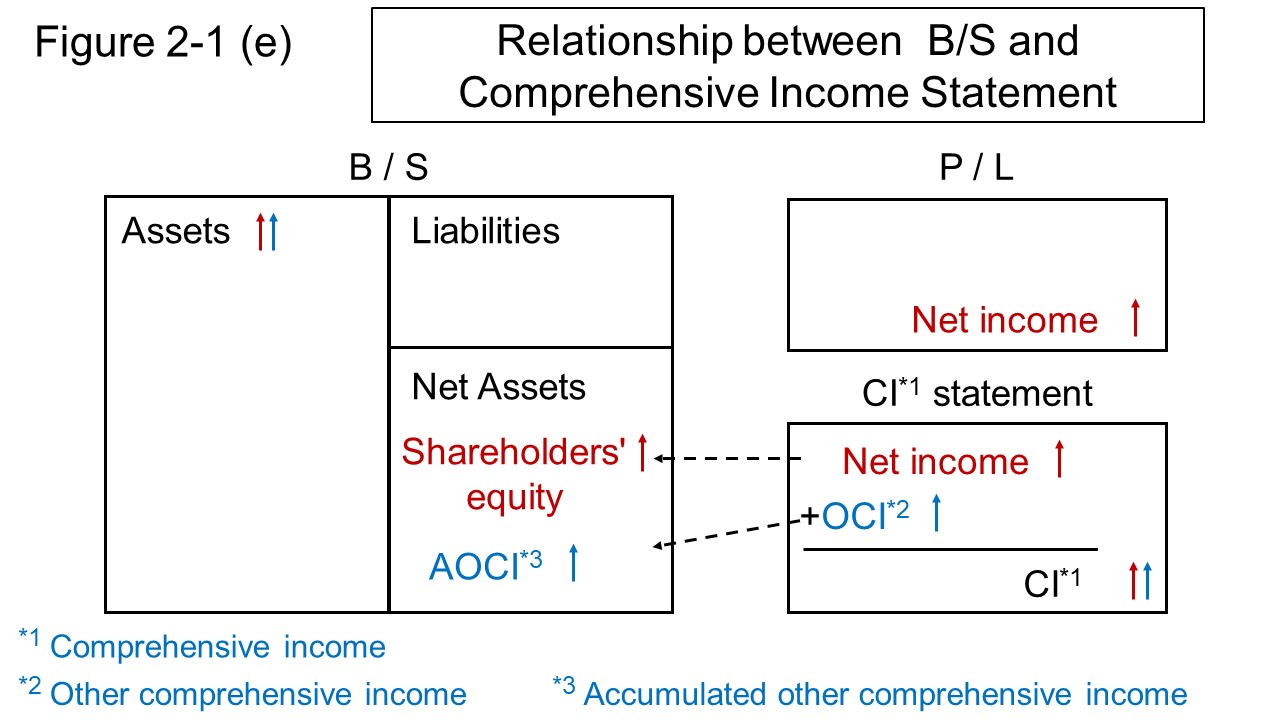
Other comprehensive income is the portion which net income is not included, of comprehensive income.
That is, unrealized valuation gains / losses other than realized net income are other comprehensive income.
Regarding the attribution of profit, it is described as "親会社株主に帰属する純利益" in the consolidated income statement,
whereas it is described as "親会社株主に係る包括利益" in the statement of comprehensive income.
"帰属する" means to attribute, and "係る" means to relate.
This indicates that the attribution of other comprehensive income is ambiguous, but comprehensive income is generally regarded as profit related to the shareholders of the parent company.
Cash flow statement (C / S) is a financial statement that describes the cash inflows and outflows of the company's cash over a period of time.
In this website, explanations will be given based on the general CF statement description method called the indirect method and the first method.
The indirect method relates how to calculate, which is written as "間接法" and is called "kansetsu hou’.
The first method relates how to describe, which is written as "第1法" and is called "dai iti hou’.
- Cash flow statement
- It is written as "キャッシュフロー計算書", and called "cash flow keisan syo", in Japan.
In C / S, "cash flow from operating activities (operating CF)", "cash flow from investing activities (investing CF)", and "cash flow from financing activities (financing CF)" are listed in this order from the top.
The sum of these cash flows, tweaked, is added to the balance at the beginning of the period to represent the balance at the end of the period, at the bottom of the statement.
since cash flow from operating activities is the most difficult to understand, C / S will be outlined in the order of financing CF, investing CF and operating CF.
Financing CF includes income and expenditures related to finance, such as fund procurement and repayment, and payment of dividends.
Below are some examples.
- Net increase / decrease in short-term loans payable
- Proceeds from long-term loans payable / Repayments of long-term loans payable
- Proceeds from issuance of bonds / Redemption of bonds
- Cash dividends paid
Investing CF mainly includes income and expenditure related to fixed assets such as capital investment, securities investment, and lending.
Below are some examples.
- expenditure on acquisition of property, plant and equipment / income from the sale of property, plant and equipment
- expenditure on acquisition of investment securities / income from the sale of investment securities
- expenditure on loans / income from loan collection
Operating CF includes cash flow related to operating profit / loss by main business and cash flow which is not included in the investing CF and financing CF among cash flow not related to operating profit / loss.
Based on the line of subtotal, cash flows related to operating profit / loss are described above it, and cash flows not related to operating profit / loss are described below it.
The top of the CF statement is net income before taxes.
Then, among the income and expenses related to the calculation of net income before taxes, the items that cash have not moved are added to or subtracted from the net income before taxes.
In addition, among the income and expenses used to calculate net income before taxes, cash flow included in investing CF and financing CF is excluded from operating cash flow to avoid double counting.
The following is an example of the items listed above the line of subtotal in operating CF.
- Depreciation, Goodwill amortization, etc.
- Decrease (increase) in notes and accounts receivable – trade / Increase (decrease) in notes and accounts payable-trade
- Increase (decrease) in allowance for doubtful accounts
Below the subtotal, the following items are listed, that have not been included in the investing CF and financing CF among the cash flow that are not related to operating income.
- Interest and dividend income received
- Interest expenses paid
- Income taxes paid
Note that cash in the cash flow statement means "cash and cash equivalents".
Cash equivalents include, in addition to cash, check deposits, time deposits set within 3 months of maturity, and commercial paper.
Therefore, the balance at the end of the cash flow statement generally does not match the "cash and deposits" on the balance sheet.
Revenues / expenses and cash inflows / outflows are exactly different, but they should finally match.
However, problems can occur in the process of getting there.
In the cash flow statement, you can read problems related to cash collection that cannot be read in the income statement.
It takes time to collect sales as cash.
For example, some of the sales are recorded as net sales in the income statement before being collected as cash, and are mainly turned into assets called accounts receivable on the balance sheet.
If the accounts receivable can be collected, the sales and the cash match, but if they cannot be collected, they do not match.
In the worst case, a company can go bankrupt if sales cannot be collected as cash.
The pattern of bankruptcy in the black is that the cash flow worsens because the business partner goes bankrupt and the accounts receivable cannot be collected, or the collection of profits is slower than the payment of expenses.
In the cash flow statement, it is most important whether the OCF is positive or not.
If the OCF is negative despite profits, especially if it continues, there may be something wrong with the company.
Again, revenues / expenses and cash inflows / outflows should finally match.
It is the function of the cash flow statement to let you confirm that.
The balance sheet contains stock information such as assets, liabilities, and net assets, and the income statement contains information on revenue and expenses.
Revenues / expenses and cash inflows / outflows are exactly different, but they should finally match.
The cash flow statement contains information for confirming that.
By reading the three financial tables together, you can grasp stock and flow information about finance, which is useful for investment.
